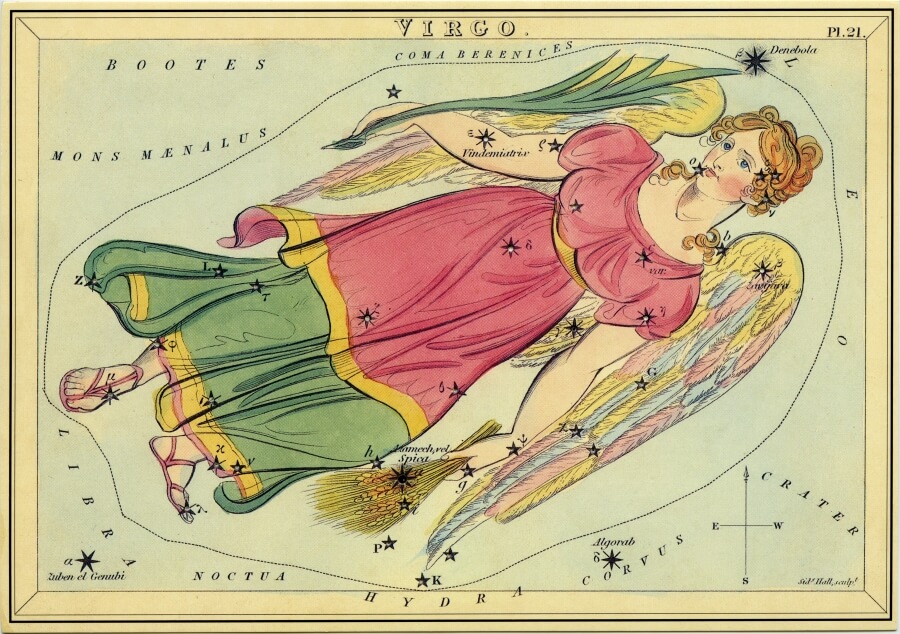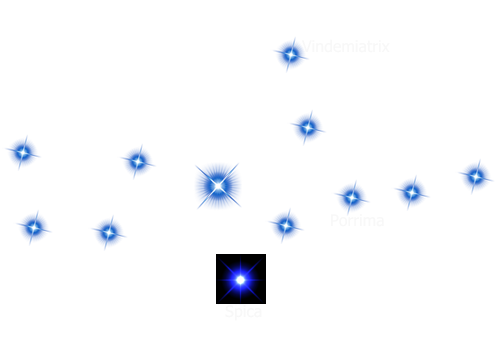Personal Daily Horoscope
Join For Free Here
Virgo - from the Box of Stars
Wholeness, self-containment, synthesis, discernment, justice, intelligence,
the harvest, the feminine, clarity, compassion

Spica, the Ear of Wheat, marks the sheaf of corn in Virgo's hand. Many temples in the ancient world were built in alignment with it.
The Sun in Virgo
With the Sun in Virgo, you have an intellectual, analytical approach to life. No detail is too small or insignificant to be ignored, as together they make up the larger picture. For real understanding, and real inner wholeness, are your goals and you need to dissect your experience so that you can synthesize it into a new whole, that has real meaning for you. But you are also very practical and down to earth and you have no time for dreams or abstract concepts if they do not make an impact on the here and now, or improve the lot of those around you.
In fact, as time goes by and you find your way in life, helping others find their inner wholeness can take pride of place, for healing, health and wholeness are the sign of Virgo's main concerns.
The Myths and Legends of Virgo
The Great Goddess of the Harvest
The winged Virgin, holding the palm branch and the Ear of Wheat which marks her brightest star, was worshipped as the great goddess of the harvest throughout the ancient world.
The earth's bounty - flowers, fruits and fields of grain - were seen as her Beloved, whom she mourned at harvest time, when he was cut down in his prime. Having spent the winter in the underworld, he was reborn each spring and reunited with her.
The origins of the cult of the Great Goddess, who was both virgin and mother, are prehistoric, but since the dawn of recorded history she has been associated with the constellation Virgo, through which the sun passes around harvest-time.
Queen of the Stars
Virgo is also the ancient Iraqi goddess Ishtar, Queen of the Stars, the lover of the corn god Tammuz, whose death she mourns each autumn, when he is cut down in his prime. Winter reigns during her journey to the underworld to bring him back, after which he reappears as the new, green corn each spring.
Venus and Adonis
The stories of Venus and Adonis, of Isis and Osiris, and of Cybele, the early Asiatic goddess in her turreted crown who loved Attis, are all variations on the theme.
In Greece, Virgo is Demeter, the goddess of the corn, as well as her daughter Persephone, who spends the winter in the underworld and returns to earth each spring.
Urania
Virgo is also the muse of astronomy, Urania, who was believed to have been placed in the skies by Apollo, the god of music and prophecy.
Goddess of Justice
To the Romans she was Astraea, the goddess of justice and of the laws of nature, who was the last of the immortals to leave 'the blood-soaked earth' after the Gold, Silver and Bronze Ages gave way to the wickedness of modern times and the Age of Iron. Her promised return, and the imminent birth of a child who would restore the Golden Age, made it easy for the Christians to see Virgo as the Virgin Mary. Astraea is also connected with the constellation of Libra, which lies next to Virgo on the zodiac band.
The Modern View of Virgo
In astrology, Virgo belongs to the element of earth and is ruled by the intellectual planet Mercury, which were both allotted to it in the second century AD.
This combination fostered the idea of 'practical mind' and so the ancient goddess of fertility and the harvest slowly changed into the Ideal Secretary, the tidy analytical perfectionist, which is the classic image of the sign today.
But the real nature and meaning of Virgo lies in the matriarchal virgin goddess of the distant past, who was later turned into the Virgin Mary. A symbol not of chastity, but of synthesis and wholeness, she was a virgin because she was independent, free and self-contained.
Mercury, Ruler of Virgo
Mercury, the versatile, quick-witted messenger of the gods and guide of souls, rules communication, commerce, wit and learning. The link between this world and the next, he was also the protector of travelers and the bringer of luck. For the Greeks, he was Hermes, the inventor of music. The planet which belongs to him lies closest to the Sun.
Mercury's colour is bright lemon yellow, its jewel is agate and its metal, mercury or quicksilver.
The Stars
Spica, the Ear of Wheat, is Virgo's most important star, and the famous temple to the many-breasted Diana of Ephesus, in Turkey, was built in alignment with it.

Virgo, seen lying on her back with her feet towards the east, is now known as the 'realm of the galaxies', as around 3000 of them, about sixty-five light years distant, are scattered over the head and shoulders and the left wing of the goddess like dim jewels.
Her Gamma star, between her left upper arm and her waist on the card, Porrima, was a Roman goddess of prophecy. Vindemiatrix, the Grape Gatherer, which marks her right arm, is so called because its morning rising occurs just before the vintage.
To Locate
Virgo, carrying the Ear of Wheat - the bright star, Spica - lies between Leo and Libra on the zodiac band, with Bootes to the north and Hydra to the south. It is best seen looking south in spring and summer in the northern hemisphere, and looking north in autumn and winter south of the equator.
In the northern hemisphere, draw an imaginary arc on down from the curved handle of the Plough, Ursa Major, to find Arcturus in Bootes and then Spica in Virgo.
As Virgo follows Leo on the zodiac band, the chariot of Cybele is drawn by lion
Get Virgo Full Report